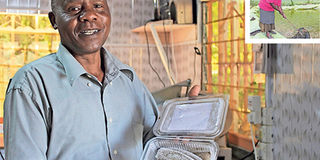Farmer smells the money in fish farming

David Ruhiu showcases products he makes from fish and (inset) his wife, Muthoni Njogu in their farm in Nyandarua County. The venture has taken him places locally and internationally, and he has won trophies and certificates that decorate his processing room, office and house. PHOTOS | WAIKWA MAINA | NATION MEDIA GROUP
What you need to know:
- The farmer recalls he spent some Sh170,000 on making his first pond, with the money going to construction and buying fingerings from the Kenya Marine and Fisheries Research Institute (KMFRI).
- In 2015, he started adding value to fish by making sausage, fillets and fish balls after attending training on agribusiness at KMFRI. But due to lack of specialised equipment, he faced many challenges.
- Three of the trophies are from the Food and Agriculture Organization and two from the Nyandarua County government for his contribution to food security, among other reputable local and international organisations.
- Though the local community has now embraced fish, his main customers are big hotels like Panari in Nairobi and others in major towns.
David Ruhiu has been keeping fish in Kiriita village, Nyandarua County, for the past 15 years, a business he started when he stocked 5,000 fingerlings in a 20-by -5 metre fish pond at his home.
Earnings from the pond eight months later enticed him to invest more in aquaculture, abandoning dairy and horticulture. He then had eight cows that he sold to invest in aquaculture.
“After doing calculations on the cost of production, time, space occupied by the pond and the cost of the produce, I felt it was a waste of time keeping dairy cows as the main business. I set up fish ponds on the entire farm,” he calls.
Today, the farmer has six large, two medium-sized and six smaller ponds with a total capacity of 150,000 different types of fish, including tilapia, mud fish and ornamental.
The farmer recalls he spent some Sh170,000 on making his first pond, with the money going to construction and buying fingerings from the Kenya Marine and Fisheries Research Institute (KMFRI).
The business has been growing since. He sells the fish to hotels, the county government and NGOs promoting fish eating in the region. He sells each fish for between Sh200 and Sh300, depending on the size.
In 2015, he started adding value to fish by making sausage, fillets and fish balls after attending training on agribusiness at KMFRI. But due to lack of specialised equipment, he faced many challenges.
“I started getting a breakthrough in August last year after importing equipment at Sh1.2 million from China and Germany,” says the farmer, who has now perfected the art.
The venture has taken him places locally and internationally, and he has won trophies and certificates that decorate his processing room, office and house.
Three of the trophies are from the Food and Agriculture Organization and two from the Nyandarua County government for his contribution to food security, among other reputable local and international organisations.
MEET HIS DEMAND
The farmer has contracted 300 small-scale farmers, whom he trains to rear and supply fish to his farm to help him meet his demand.
“One of the equipment requires 160 kilogrammes of fish per hour, a demand my farm and local farmers cannot supply, forcing me to source from outside the county, including Nyeri, Kiambu, Laikipia and western,” explains Ruhiu, adding that he buys fish from farmers at Sh300 per kilo.
Fish has taken the farmer far, he says. “Everything you see in this compound is from fish. I used to ride a bicycle to hawk the fish but I now own two vehicles. I lived in a semi-permanent house but my family is now in a bigger permanent house. I have bought some additional land in other places and educated my children.”
Though the local community has now embraced fish, his main customers are big hotels like Panari in Nairobi and others in major towns.
He also sells more during farmers’ field days, agricultural shows and exhibitions across the country, which he diligently tours.
“We need to encourage more farmers to venture into fish farming. I need fish, and I pay at the pond, but a farmer must be trained to produce the desired quality and quantity per pond,” says Ruhiu, who isolates predators such as human and birds and unreliable power supply that affect his aquariums as his major challenges.
David Kamau, Nyandarua fish extension officer, says one can start value addition small with Sh50, 000 processing equipment.
“You do not need to produce all that you process since you can buy from other farmers,” he says.
The products, however, must be approved by the Kenya Bureau of Standards. “The main challenge in processing is sustaining the demand, thus, one must invest heavily in fish ponds. You can make your own feeds to reduce the cost of production and also sale to other farmers,” says Kamau.





